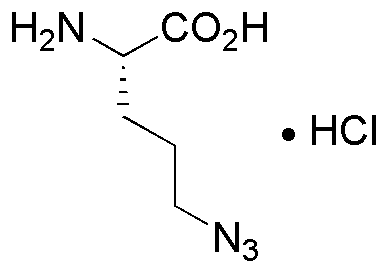Nd-Azido-L-Ornithine hydrochloride is widely utilized in research focused on:
- Bioconjugation: This compound serves as a versatile building block for bioconjugation techniques, allowing researchers to attach biomolecules to surfaces or other molecules, enhancing drug delivery systems.
- Protein Labeling: It is used in the labeling of proteins for imaging and tracking within biological systems, facilitating studies in cellular dynamics and protein interactions.
- Drug Development: The azido group in this compound makes it valuable in the development of new pharmaceuticals, particularly in creating targeted therapies for various diseases.
- Click Chemistry: Its compatibility with click chemistry reactions allows for efficient and selective synthesis of complex molecules, streamlining the process of drug discovery.
- Research in Neuroscience: This compound is also being explored in neuroscience research for its potential to modify neurotransmitter pathways, providing insights into neurological disorders.
General Information
Properties
Safety and Regulations
Applications
Nd-Azido-L-Ornithine hydrochloride is widely utilized in research focused on:
- Bioconjugation: This compound serves as a versatile building block for bioconjugation techniques, allowing researchers to attach biomolecules to surfaces or other molecules, enhancing drug delivery systems.
- Protein Labeling: It is used in the labeling of proteins for imaging and tracking within biological systems, facilitating studies in cellular dynamics and protein interactions.
- Drug Development: The azido group in this compound makes it valuable in the development of new pharmaceuticals, particularly in creating targeted therapies for various diseases.
- Click Chemistry: Its compatibility with click chemistry reactions allows for efficient and selective synthesis of complex molecules, streamlining the process of drug discovery.
- Research in Neuroscience: This compound is also being explored in neuroscience research for its potential to modify neurotransmitter pathways, providing insights into neurological disorders.
Documents
Safety Data Sheets (SDS)
The SDS provides comprehensive safety information on handling, storage, and disposal of the product.
Product Specification (PS)
The PS provides a comprehensive breakdown of the product’s properties, including chemical composition, physical state, purity, and storage requirements. It also details acceptable quality ranges and the product's intended applications.
Certificates of Analysis (COA)
Search for Certificates of Analysis (COA) by entering the products Lot Number. Lot and Batch Numbers can be found on a product’s label following the words ‘Lot’ or ‘Batch’.
*Catalog Number
*Lot Number
Certificates Of Origin (COO)
This COO confirms the country where the product was manufactured, and also details the materials and components used in it and whether it is derived from natural, synthetic, or other specific sources. This certificate may be required for customs, trade, and regulatory compliance.
*Catalog Number
*Lot Number
Safety Data Sheets (SDS)
The SDS provides comprehensive safety information on handling, storage, and disposal of the product.
DownloadProduct Specification (PS)
The PS provides a comprehensive breakdown of the product’s properties, including chemical composition, physical state, purity, and storage requirements. It also details acceptable quality ranges and the product's intended applications.
DownloadCertificates of Analysis (COA)
Search for Certificates of Analysis (COA) by entering the products Lot Number. Lot and Batch Numbers can be found on a product’s label following the words ‘Lot’ or ‘Batch’.
*Catalog Number
*Lot Number
Certificates Of Origin (COO)
This COO confirms the country where the product was manufactured, and also details the materials and components used in it and whether it is derived from natural, synthetic, or other specific sources. This certificate may be required for customs, trade, and regulatory compliance.


